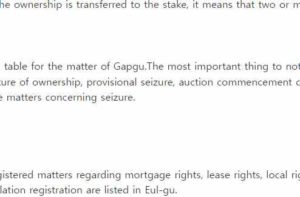We will learn how to view and issue registers through the Internet Registry and how to view and issue them through the Internet Registry.
Unless you are office workers, I think that the most common individual will use the real estate register copy when reading the register copy. Since the copy of the corporate register is mainly used by office workers or other related workers, we will talk about viewing the copy of the real estate register here.
○ What is a copy of the register?
In a dictionary sense, it is defined as a copy of the register that records the relationship of rights to real estate. A copy of the real estate register is used the most when auctioning real estate or purchasing apartments because anyone can view and issue registration records and check the relationship of ownership of the real estate they want to check.
○ View a copy of the register
In order to view a copy of the register, you must access the website of the Supreme Court’s Internet Registry and log in first. You do not have to log in when you read a copy of the register, but we recommend that you sign in and log in to check the issuance and other matters later.
Log in to the homepage and view real estate → view/issue → view
If you wish to issue it, please click Issue. Please note that the reading fee is 700 won and the issuance fee is 1,000 won.
Internet Registry – Website
After pressing the view button, you are required to enter the address of the real estate to be inquired. You can find it by location number and road name address, and these days, most of them are by road name address, so you can search by road name address.
If you enter the real estate classification, city/province, address, and search in order, the address of the real estate will be displayed at the bottom, and if you keep pressing the next button, the payment button window will appear.
Press the payment button and click on the payment method you want to proceed with the payment. It’s not as hard as you think, and you can do it quickly.
The method of reading and issuing a certified copy of the register is the same, and if you click on whether to view and issue it on the first page, the rest will proceed in the same way, so I don’t think there will be any difficulties.
○ Points to note when viewing and issuing a copy of the register
If you proceed by reading the registered copy and complete the payment, you can view the registered copy of the real estate, but it is literally open, so it cannot be printed.
If you close the window, you can’t read it again, so please check it carefully.
When you proceed with the issuance of a copy of the register, please make sure to test the printer output before printing. It’s annoying, so if you just print it out, but it doesn’t work properly due to a printer error, you can’t print it out again.
Therefore, please make sure to test the output and print out the original. I also paid 1,000 won again because I couldn’t print properly due to a printer error, so it is essential to check the printer in advance.
Registered copies are not available free of charge. The reading fee is 700 won and the issuance fee is 1,000 won, so please check the advantages, and if possible, we will add 300 won more, so it would be better.
○How to view a copy of the register
It is not difficult to see a copy of the register.There are headlines, Gap-gu, and Eul-gu, and I will explain mainly the parts that must be checked.
1. Header section
In the case of registration, one registration form is used for one piece of land or one building, which is called the first real estate landowner.
In other words, the register must be organized in units of one real estate, which is an object of rights. You can check the date, location number, location, location, and area of the registration application.
2. Gapgu
Seizure of ownership, provisional registration, registration of auction commencement decision, notice registration that a trial on cancellation or restoration of ownership is underway, and provisional disposition registration prohibiting the owner’s disposition are all to be entered in Gap-gu.
In addition, matters related to the change and extinction of these rights relations are also listed in Gap-gu.The ownership preservation registration is the first registration for the real estate, and if the ownership is transferred to the stake, it means that two or more people jointly own the real estate.
Gapgu-Example
Here is an example table for the matter of Gapgu.The most important thing to note in Gap-gu is that if a registered creditor seized or seized the debtor’s property to secure bonds, such as seizure of ownership, provisional seizure, auction commencement decision, and provisional disposition, the real estate will eventually be auctioned. In Gap-gu, you must check the matters concerning seizure.
3. District
Write down the registered matters regarding mortgage rights, lease rights, local rights, and superficies, which are rights other than ownership.Mortgage, lease, area, superficies, transfer and cancellation registration are listed in Eul-gu.
Eulgu-Example
In Eul-gu, the most important part is not the debt borne by the highest debtor of the collateral security bond in reality, but the maximum amount of debt to be borne in the future, and it is common practice that the actual debt is about 80% of the maximum amount.
If the debtor does not repay all the mortgage bonds, the real estate will eventually be destined to be auctioned, and if the leasehold is established, the leaseholder cannot be arbitrarily discharged during the lease period unless there are special circumstances.